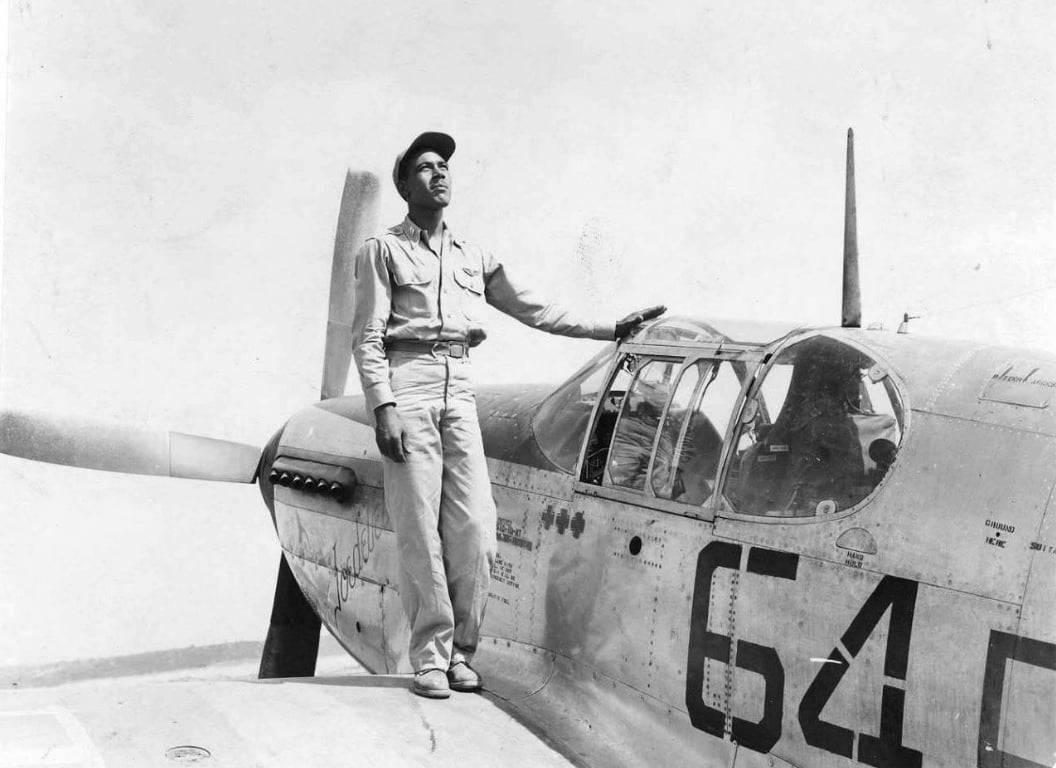U.S. Army Air Force World War II veteran Joseph Dubois Elsberry was the first Black fighter pilot to shoot down three German aircraft in a single mission.
Elsberry was born on April 25, 1921, in Langston, Oklahoma. His father was Joseph Dean Elsberry, and his mother was Beulah Elsberry. Both parents were teachers. He had an older sister, also named Beulah. Before joining the military, he was a student at Langston University for three years. Twenty-year-old Elsberry joined the U.S. Army in Oklahoma City on February 19, 1942.
Elsberry was accepted into the Tuskegee Army Airfield Training Program and graduated from the Tuskegee Army Flying School on September 6, 1942. He was part of Class 42-H-SE and graduated as a Second Lieutenant. Elsberry became the 37th Black pilot commissioned by the U.S. Army Air Corps. He developed a reputation for being aggressive and fearless during training, traits which would aid him in combat.
Elsberry was assigned to the 332nd Fighter Group’s 301st Fighter Squadron. The Squadron’s pilots painted the tails of their P-47 and later P-51 fighter planes, giving them the nickname “Red Tails.” They escorted B-47 Bombers during missions over Nazi-controlled Europe, and the bomber crews would call them “Red-tail angels” because of the protection they provided.
By 1944, Elsberry was a first Lieutenant stationed in Italy. On June 23, 1944, he led his squadron of P-51 fighter planes in a mission at Trieste Harbor on the Adriatic Sea and sunk a German destroyer warship, remarkably without bombs but with .50 caliber machine guns.
On July 12, 1944, Elsberry was on a mission leading fighters based out of Ramitelli, Italy, from the 332nd Group, escorting B-17 bombers of the 5th Bombardment Wing to a target in France. Elsberry detected approaching enemy fighters and engaged them. He shot down three confirmed Focke-Wulf Fw 190 German aircraft and a fourth probable Fw 190.
In July 1944, Elsberry was promoted to Captain. His fourth and final aerial victory was on July 20, 1944, when he shot down a Messerschmitt Bf 109. For these feats, Elsberry was awarded the Distinguished Flying Cross. For his heroism in battle, Elsberry was also awarded the Air Medal with six Oak Leaf Clusters.
Elsberry and the other Tuskegee Airmen were given grudging respect by their German opponents, who called the 99th Fighter Squadron Der Schwarze Vogelmenschen or “Black Birdmen.” Their ability to protect their bombers and fearlessness in repelling enemy planes led to three Squadrons being awarded Distinguished Unit Citations.
In 1946, after the end of World War II, the Tuskegee Airmen were deactivated, and all the Army Air Force Squadrons were racially integrated. In 1947, the Air Force became a separate military branch, and Elsberry would serve in the Korean War. In 1962 after 20 years of military service, he retired as a Major at the age of 41. Elsberry had served his country in Europe, Japan, and Korea over the course of his military career.
Joseph Elsberry moved to San Francisco after retirement and worked for the Western Electric Company until 1977. On March 31, 1985, he died from a heart attack at the age of 63. He was interred at Arlington National Cemetery.
Do you find this information helpful? A small donation would help us keep this available to all. Forego a bottle of soda and donate its cost to us for the information you just learned, and feel good about helping to make it available to everyone.
BlackPast.org is a 501(c)(3) non-profit and our EIN is 26-1625373. Your donation is fully tax-deductible.
CAF Rise Above, “Joseph Dubois Elsberry,” CAF Rise Above https://cafriseabove.org/joseph-d-elsberry/; Ann DeFrange, “Langston Alumni Made History as War Pilots,” The Oklahomanhttps://www.oklahoman.com/story/news/1994/12/25/langston-alumni-made-history-as-war-pilots/62404708007/
Your support is crucial to our mission.
Donate today to help us advance Black history education and foster a more inclusive understanding of our shared cultural heritage.

